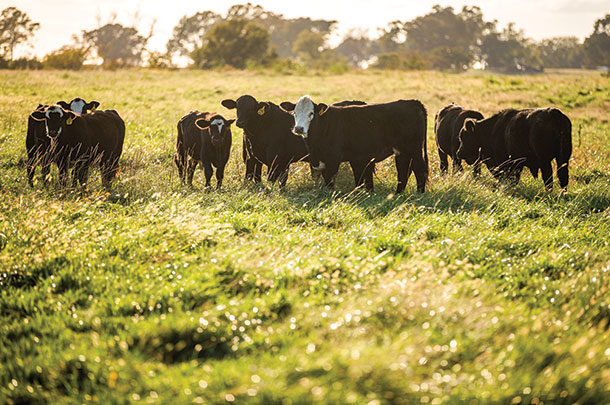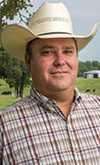At a recent conference, I had the opportunity to listen to an order buyer for several of the large Midwestern feedlots. He was very straightforward and transparent with his comments to the crowd. When asked what top three factors he looks for when buying cattle either off the ranch or at a livestock market, his reply was: health, health and health.
He continued, stating that the best genetics and feeding program in the country can be undone by poor health management and protocols. Sick animals can rarely reach adequate average daily gain (ADG) or feed conversion ratios to remain profitable, and they tend to have lower-quality carcasses. It goes without saying: Dead animals wreck closeouts.
So a common question is: “What goes into developing healthy, reputation calves that buyers will compete for and pay top dollar to purchase?” This is not a simple question to answer, as it is multifaceted.
The main factors include:
- An effective nutrition program
- Complete herd health program
- Genetics
- Proper stock handling
- Good regenerative management of the operation
Now let’s look deeper into each of the above factors.
An effective nutrition program
Hippocrates stated nearly 2,500 years ago, “All disease begins in the gut.” Conversely, health also begins in the gut. Nutrition is the basis of good health, not only for humans but for livestock. Nutrition goes hand-in-hand with a quality vaccine program. Vaccination programs are only effective when the animal is properly nourished.
Herd nutrition starts in the pasture while the calf is developing as a fetus and does not stop until harvest. Fetal programming can have a dramatic impact on calf health and its later performance. One recent study indicated a positive relationship between feeding sufficient/excess protein to a gestating cow and a higher marbling score for its calf at harvest.
The cow and calf must be well fed, which not only means providing adequate forage quality and quantity to satisfy protein and energy requirements but also providing free-choice access to quality minerals. Mineral status can play an important role in the ability of an animal to respond to vaccines, diseases and growth.
Complete herd health program
Herd health protocols are numerous and varied in the industry. It’s not possible or practical to identify one health protocol as being the best for all situations across the country; circumstances dictate the right program for each producer. Consult with a veterinarian to determine the best health protocol for your ranch and intended marketing program on an annual basis.
With that said, the use of a modified live viral (MLV) instead of a killed virus (KV) viral respiratory vaccine should be part of all herd health programs, both for breeding stock and calves. Timing and number of booster injections will vary based on the cattle type, location, time of marketing and previous vaccination history. However, VAC 45 preconditioning programs typically require two rounds of the viral respiratory vaccine, even though many MLV products are now labeled for one dose. Regardless of how many boosters a calf receives, preference is to use a 5-way rather than a 4-way vaccine for the viral respiratory complex of diseases.
The cow herd also should be on an annual MLV viral respiratory vaccine program as well as blackleg vaccination and deworming programs. The benefits include the possibility of in utero immune system fetal programming and development of more enriched colostrum for the calf.
Before converting an existing cow herd to MLV, consult with a veterinarian, state extension livestock specialist or livestock consultant about timing of the initial vaccine administration and products to use to stay within the vaccine label indications.
In addition to the MLV, it’s a good idea for calves that aren’t harvested directly off the ranch to receive two rounds of a blackleg vaccination and to be dewormed, if needed, early in the stocker or yearling phase. Furthermore, calves should receive at least one round of a viral shipping fever vaccine at least 30 days prior to leaving the ranch of origin. Recent feedlot data indicates that bovine respiratory viral disease (BRD) incidence rates have been increasing at an alarming rate for the past decade. There still is a need in the industry to conduct research to determine the optimal timing of vaccinations based on the calf’s genetic capacity, age and time of marketing.
Genetics
Do not overlook calf genetics. Currently, there is no DNA test available to determine if an animal is predisposed to certain diseases. If one could be developed, it could become a game-changer for the industry. Feedlots would likely be interested in buying cattle with lower risk for certain diseases.
 Regenerative ranching practices should be used to improve pasture quality and, subsequently, calf health. Photo courtesy of Noble Research Institute.
Regenerative ranching practices should be used to improve pasture quality and, subsequently, calf health. Photo courtesy of Noble Research Institute.
Recently, I have been thinking about the genetic progression of cattle and how that might relate to today’s health challenges. We now have a much higher number of calf-feds entering the feedlot because they are reaching the desired target weight at an earlier age. From 2006 to 2021 for non-parent Angus expected progeny differences (EPDs), a bull that would have been ranked at breed average for weaning weight and yearling weight in 2006 would now be ranked in the 90th and 90th percentiles, respectively.
Breed average birthweight in 2006 would now be in the 75th percentile. Likewise, 2006 breed average for marbling would be ranked at the 90th percentile. Thus, I question whether vaccination protocols have kept up with modern genetics. Most industry-recognized vaccine protocols are several decades old and may need to be updated to best fit modern-day cattle. Likewise, has the industry pushed the animal’s genetic capacity for growth and marbling to the point that health may become compromised?
Proper livestock handling
Quality vaccination programs and proper nutrition come at a high financial cost. Do not jeopardize efficacy of either with poorly built facilities and bad handling technique. Poorly designed facilities stress cattle and cost money. The use of under- or untrained dogs and personnel is costly and dangerous for both human and animal. Understand animal behavior and how cattle will react relative to your body position to theirs.
Do not use cattle prods, and only use flags or paddles sparingly as a guide for the animal rather than as a physical deterrent. Use low-stress handling facilities that incorporate curved and solid sides or a Bud box design, and move the cattle in a calm, quiet and slow manner. Observe cattle flow and movement in your operation, then work to reduce distractions or barriers that impede an animal from willingly moving calmly.
Regenerative management
Regenerative ranching practices should be used to improve pasture quality and, subsequently, calf health. Remember, everything that occurs on the ranch will have an impact on the future quality, health and performance of the calves. Factors from stocking density, soil health and forage availability to record-keeping can impact calves.
Regenerative techniques, such as adaptive multipaddock (AMP) grazing, directly impact animal health/performance and simultaneously improve the land. AMP grazing helps animals become more accustomed to human interaction, reducing handling stress. AMP also ensures animals are eating a diverse diet of the best-quality forage, helping them meet nutritional requirements and reducing both under- and overgrazing.
Other regenerative practices can complement herd health, including removing from the herd poor-performing cows and those requiring routine deworming. For producers who retain heifers as replacements, use bulls with moderate frame scores and performance trait EPDs in order to create a uniform heifer that will be moderate in size and profitably fit her environment.
Cow-calf producers have the power to influence the future success of calves coming off their ranches by investing in their health early on. It’s not only the right thing to do, your ranch reputation – and price potential for future calves – depends on it.












